“Maximizing Solar Efficiency: Understanding the Crucial Role of Shading on Wiring Performance.”
Shading significantly affects the performance of solar wiring systems by reducing the amount of sunlight that reaches the photovoltaic (PV) cells, leading to decreased energy output. When parts of a solar panel are shaded, it can create imbalances in the electrical current, causing hotspots and potential damage to the cells. This phenomenon can also lead to a reduction in overall system efficiency, as the performance of the entire array can be compromised by the underperformance of a single shaded panel. Understanding the impact of shading is crucial for optimizing solar energy systems, ensuring proper installation, and implementing effective mitigation strategies to maximize energy production.
Shading Effects on Solar Panel Efficiency
The impact of shading on solar wiring performance is a critical consideration for anyone looking to optimize the efficiency of solar energy systems. Solar panels are designed to convert sunlight into electricity, and their performance is directly linked to the amount of sunlight they receive. When shading occurs, whether from trees, buildings, or other obstructions, it can significantly diminish the energy output of solar panels. Understanding the nuances of how shading affects solar panel efficiency is essential for maximizing energy production and ensuring a reliable return on investment.
To begin with, it is important to recognize that solar panels are typically composed of multiple solar cells connected in series. When one cell is shaded, it can create a bottleneck effect, reducing the overall current flowing through the entire string of cells. This phenomenon is known as the “hot spot” effect, where the shaded cell can become overheated due to the excess energy being generated by the unshaded cells. Consequently, this not only reduces the efficiency of the entire panel but can also lead to permanent damage over time. Therefore, even partial shading can have a disproportionately large impact on the performance of solar panels.
Moreover, the type of shading plays a significant role in determining the extent of efficiency loss. For instance, intermittent shading, such as that caused by passing clouds or moving objects, may have a less severe impact compared to consistent shading from a nearby tree or building. In cases of intermittent shading, solar panels may still generate a substantial amount of energy during periods of full sunlight. However, consistent shading can lead to a more pronounced drop in energy output, making it crucial for solar system designers to assess potential shading issues during the planning phase.
In addition to the physical effects of shading, the technological advancements in solar panel design have introduced solutions to mitigate these challenges. For example, bypass diodes are commonly integrated into solar panels to minimize the impact of shading. These diodes allow current to bypass shaded cells, thereby reducing the risk of hot spots and maintaining a more consistent energy output. While this technology can help improve performance under shaded conditions, it is not a panacea. The effectiveness of bypass diodes is contingent upon the extent and nature of the shading, and they cannot fully compensate for significant shading issues.
Furthermore, the orientation and tilt of solar panels can also influence their susceptibility to shading. Panels that are installed at an optimal angle and direction can capture more sunlight throughout the day, thereby reducing the likelihood of shading from surrounding objects. This highlights the importance of site assessment and careful planning in the installation process. By considering factors such as the path of the sun, seasonal changes, and potential obstructions, solar installers can significantly enhance the performance of solar energy systems.
In conclusion, the effects of shading on solar panel efficiency are multifaceted and warrant careful consideration. From the physical implications of shading on solar cells to the technological solutions available, understanding these dynamics is essential for anyone involved in solar energy. By addressing shading issues proactively, whether through strategic planning or the use of advanced technologies, stakeholders can ensure that solar systems operate at their highest potential, ultimately contributing to a more sustainable energy future.
The Role of Bypass Diodes in Shaded Solar Arrays

In the realm of solar energy, the efficiency of photovoltaic (PV) systems can be significantly compromised by shading. Whether caused by trees, buildings, or even dust accumulation, shading can lead to a reduction in the overall output of solar panels. To mitigate this issue, the integration of bypass diodes plays a crucial role in enhancing the performance of shaded solar arrays. Bypass diodes are semiconductor devices that allow current to bypass shaded or malfunctioning sections of a solar panel, thereby minimizing the impact of shading on the entire system.
When a solar panel is partially shaded, the shaded cells can become a source of resistance, leading to a phenomenon known as “hot spotting.” This occurs when the shaded cells generate less power than their unshaded counterparts, causing them to heat up excessively. If left unaddressed, this can lead to permanent damage to the solar panel. Bypass diodes are strategically placed within the solar array to prevent this from happening. By providing an alternative pathway for the current, these diodes ensure that the unshaded cells continue to operate efficiently, thus preserving the overall energy output of the system.
Moreover, the configuration of bypass diodes can vary depending on the design of the solar panel. Typically, each solar panel is equipped with one or more bypass diodes that are connected in parallel with specific groups of cells. This arrangement allows for a more effective response to shading. For instance, if one section of a panel is shaded, the bypass diode will redirect the current around the affected cells, allowing the remaining cells to contribute to the energy production without interruption. This design not only enhances the performance of the solar array but also extends the lifespan of the panels by reducing the risk of thermal damage.
In addition to protecting against hot spotting, bypass diodes also improve the overall reliability of solar systems. In real-world applications, shading conditions can change throughout the day due to the movement of the sun or the shifting of shadows cast by nearby objects. By incorporating bypass diodes, solar arrays can adapt to these changing conditions more effectively. This adaptability is particularly important in urban environments where shading is often unpredictable. As a result, systems equipped with bypass diodes can maintain a more consistent energy output, even in less-than-ideal conditions.
Furthermore, the use of bypass diodes can lead to improved energy yield over the lifespan of a solar installation. Studies have shown that systems with bypass diodes can produce significantly more energy compared to those without, especially in areas where shading is a common issue. This increased energy yield not only enhances the return on investment for solar system owners but also contributes to the overall efficiency of solar energy as a renewable resource.
In conclusion, the role of bypass diodes in shaded solar arrays cannot be overstated. By allowing current to bypass shaded cells, these diodes protect against hot spotting, enhance reliability, and improve energy yield. As the demand for solar energy continues to grow, understanding and implementing effective solutions like bypass diodes will be essential for maximizing the performance of solar installations. Ultimately, the integration of these components represents a significant advancement in solar technology, ensuring that even in the face of shading challenges, solar energy remains a viable and efficient source of power.
Analyzing Shading Patterns and Their Impact on Energy Output
The performance of solar wiring systems is significantly influenced by shading patterns, which can drastically alter energy output. Understanding how different types of shading affect solar panels is crucial for optimizing their efficiency and ensuring maximum energy production. When solar panels are partially or fully shaded, the amount of sunlight they receive diminishes, leading to a corresponding decrease in energy generation. This phenomenon is particularly pronounced in systems that are not designed to handle shading effectively.
To begin with, it is essential to recognize that shading can occur from various sources, including trees, buildings, and even dirt or debris on the panels themselves. Each of these factors can create unique shading patterns that impact the performance of solar wiring. For instance, shading from a nearby tree may only affect a portion of the solar array, while shading from a building could cover multiple panels. The extent and duration of shading are also critical; intermittent shading can lead to fluctuations in energy output, while consistent shading can result in a more permanent reduction in efficiency.
Moreover, the configuration of the solar panels plays a vital role in how shading affects energy output. In a series wiring configuration, where panels are connected in a string, the performance of the entire string can be compromised by the shading of a single panel. This is due to the way electricity flows through the system; if one panel is shaded and produces less energy, it can limit the output of the entire string. Conversely, in a parallel configuration, where panels are connected independently, the impact of shading is mitigated, allowing unaffected panels to continue generating energy. Therefore, understanding the wiring configuration is essential for assessing the potential impact of shading on energy output.
In addition to wiring configurations, the angle and orientation of solar panels can also influence how shading affects performance. Panels that are tilted at an optimal angle for sunlight exposure may experience less shading throughout the day compared to those that are flat or poorly oriented. This highlights the importance of site assessment and proper installation to minimize shading effects. By strategically positioning solar panels to avoid potential shading sources, installers can enhance energy output and improve overall system performance.
Furthermore, advancements in technology have led to the development of solutions designed to mitigate the effects of shading. For example, microinverters and power optimizers can be employed to enhance the performance of individual panels, allowing them to operate independently of one another. This means that even if one panel is shaded, the others can continue to function at their optimal capacity, thereby reducing the overall impact on energy output. Such innovations represent a significant step forward in addressing the challenges posed by shading.
In conclusion, analyzing shading patterns is essential for understanding their impact on solar wiring performance. The interplay between shading sources, panel configuration, and technological advancements can significantly influence energy output. By recognizing the importance of these factors, solar energy systems can be designed and installed to minimize shading effects, ultimately leading to improved efficiency and greater energy production. As the demand for renewable energy continues to grow, addressing shading challenges will be vital for maximizing the potential of solar power and ensuring its viability as a sustainable energy source.
Strategies to Minimize Shading in Solar Installations
The performance of solar installations is significantly influenced by shading, which can drastically reduce energy output and efficiency. To mitigate the adverse effects of shading, several strategies can be employed during the design and installation phases of solar systems. Understanding these strategies is crucial for maximizing the energy yield of solar panels and ensuring a sustainable return on investment.
One of the most effective strategies to minimize shading is careful site selection. Before installation, a thorough assessment of the site should be conducted to identify potential sources of shade, such as trees, buildings, or other structures. This assessment should take into account seasonal variations in sunlight exposure, as the angle of the sun changes throughout the year. By choosing a location that receives ample sunlight throughout the day, solar installations can operate at their optimal capacity. Additionally, it is advisable to consider the future growth of nearby vegetation, as trees that may not currently cast shade could grow to obstruct sunlight in the coming years.
Another important strategy involves the strategic placement and orientation of solar panels. By adjusting the tilt and direction of the panels, installers can optimize their exposure to sunlight while minimizing the impact of shading. For instance, panels can be oriented to face true south in the Northern Hemisphere, which generally maximizes solar gain. Furthermore, using adjustable mounting systems allows for modifications in panel angles, enabling better performance during different seasons. This flexibility can be particularly beneficial in areas where shading conditions may vary throughout the year.
In addition to site selection and panel orientation, the use of advanced technology can significantly reduce the impact of shading on solar performance. One such technology is the implementation of microinverters or power optimizers. Unlike traditional string inverters, which can cause the entire system to underperform due to shading on a single panel, microinverters and power optimizers allow each panel to operate independently. This means that even if one panel is shaded, the others can continue to generate electricity at their full capacity, thereby enhancing overall system performance.
Moreover, regular maintenance and monitoring of solar installations play a crucial role in minimizing shading effects. Keeping panels clean and free from debris ensures that they can capture as much sunlight as possible. Additionally, routine inspections can help identify any new sources of shading that may have developed over time, such as growing trees or nearby construction. By addressing these issues promptly, system owners can maintain optimal performance levels.
Furthermore, community planning and collaboration can also contribute to reducing shading in solar installations. Engaging with local authorities and stakeholders to promote policies that encourage the planting of low-growing vegetation near solar arrays can help minimize shading while still allowing for green spaces. This collaborative approach not only benefits individual solar installations but also supports broader sustainability goals within the community.
In conclusion, minimizing shading in solar installations is essential for maximizing energy output and ensuring the longevity of solar systems. By employing strategies such as careful site selection, optimal panel placement, the use of advanced technologies, regular maintenance, and community collaboration, solar system owners can significantly enhance their installations’ performance. As the demand for renewable energy continues to grow, understanding and implementing these strategies will be vital for achieving efficient and effective solar energy solutions.
Q&A
1. **Question:** How does shading affect the performance of solar panels?
**Answer:** Shading can significantly reduce the energy output of solar panels by blocking sunlight, which decreases the amount of electricity generated.
2. **Question:** What is the impact of shading on solar wiring systems?
**Answer:** Shading can cause uneven current flow in solar wiring systems, leading to hotspots, potential damage to the panels, and reduced overall system efficiency.
3. **Question:** How can shading be mitigated in solar installations?
**Answer:** Shading can be mitigated by careful site selection, using solar panel optimizers, or installing microinverters to ensure that shaded panels do not affect the performance of the entire system.
4. **Question:** What are the long-term effects of shading on solar energy systems?
**Answer:** Long-term shading can lead to decreased energy production, increased maintenance costs, and potentially shorter lifespans for solar panels due to thermal stress and damage.
Conclusion
Shading significantly impacts solar wiring performance by reducing the amount of sunlight that reaches the solar panels, leading to decreased energy production. When even a small portion of a panel is shaded, it can cause a drop in voltage and overall output, affecting the entire system’s efficiency. This phenomenon is exacerbated in series-connected systems, where the performance of the entire string can be limited by the shaded panel. To mitigate these effects, strategies such as optimizing panel placement, using microinverters or power optimizers, and implementing proper maintenance practices are essential. Overall, effective management of shading is crucial for maximizing the performance and reliability of solar energy systems.




